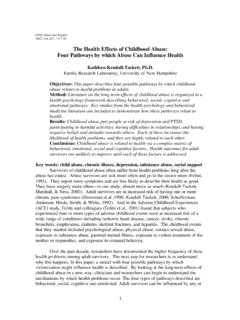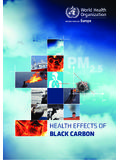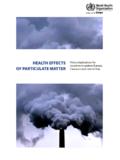Transcription of Health Protection Agency - World Health …
1 Health Protection Agency Compendium of Chemical Hazards: Diesel. Prepared by: Robert P Chilcott Chemical Hazards and Poisons Division (HQ), Chilton, Didcot, Oxfordshire, OX11 0RQ, United Kingdom. Disclaimer This guidance has been provided by the Chemical Hazards and Poisons Division of the UK Health Protection Agency (HPA). It is general guidance based on current knowledge and understanding. The HPA does not warrant that the information and guidance is complete and correct for use in all circumstances. The HPA shall not be liable for any damages that might be incurred as a result of the use of the guidance or information.
2 HPA Compendium of Chemical Hazards Diesel Key Points Fire Flammable Vapour / air mixtures may be explosive Use foam and liquid-tight protective clothing with breathing apparatus Health Irritating to eyes, respiratory ststem and skin Severe lung injury may occur following aspiration of liquid Possible carcinogen Environment Dangerous for the environment Inform Environment Agency of substantial incidents Prepared by R P Chilcott, CHAPD HQ. 2006. Version 1. DIESEL CONTENTS. Contents GENERAL INFORMATION. Background Production and Uses Frequently Asked Questions INCIDENT MANAGEMENT.
3 Hazard Identification Standard (UK) Dangerous Goods Emergency Action Codes Chemical Hazard Information and Packaging for Supply Classification(). Physicochemical Properties Threshold Toxicity Values Published Emergency Response Guidelines Emergency Response Planning Guideline (ERPG) Values Acute Exposure Guideline Levels (AEGLs). Exposure Standards, Guidelines or Regulations Occupational standards Public Health guidelines Health Effects Major route of exposure Immediate Signs or Symptoms of Acute Exposure Decontamination and First Aid Dermal exposure Ocular exposure Inhalation Ingestion TOXICOLOGICAL OVERVIEW.
4 Toxicological Overview Summary of Health effects Kinetics and metabolism Sources and route of human exposure Health Effects of Acute / Single Exposure Human Data General toxicity Inhalation Ingestion Dermal / ocular exposure Neurotoxicity Nephrotoxicity Delayed effects following an acute exposure Animal and In-Vitro Data General toxicity Delayed effects following an acute exposure Health Effects of Chronic / Repeated Exposure Human Data General toxicity Inhalation Ingestion Dermal / ocular exposure Genotoxicity Carcinogenicity Reproductive and developmental toxicity Animal and In-Vitro Data General toxicity Inhalation Ingestion Dermal / ocular exposure Genotoxicity Carcinogenicity Reproductive and developmental toxicity References Annex I: Categories of diesel additives.
5 Annex II: UK Classification of fuel oils. Annex III: UK Physicochemical standards for diesel Diesel General information Key Points Fire Flammable Vapour / air mixtures may be explosive Use foam and liquid-tight protective clothing with breathing apparatus Health Irritating to eyes, respiratory system and skin Chemical pneumonitis may arise following aspiration of vomitus (secondary to ingestion) or inhalation of aerosol (or aspiration of liquid) during manual siphoning Prolonged skin exposure may cause skin irritation Possible carcinogen Diesel is considered not to be a human reproductive or developmental toxicant Environment Dangerous for the environment Inform Environment Agency of substantial incidents Prepared by R P Chilcott, CHAPD HQ.
6 2006. Version 1. DIESEL GENERAL INFORMATION. Background Diesel is a complex mixture of chemicals mainly obtained from the distillation of crude oil. The product is thought to be named after Dr Rudolf Diesel, a German engineer who, in 1892, patented an oil-burning internal combustion engine. Modern diesel engines also incorporate features of a design (patented between 1886 and 1890) by the Yorkshireman Herbert Akroyd Stuart . The use of diesel to clean skin and hair In the UK, diesel' or DERV refers to a fuel should be strongly discouraged as this for running cars, vans and lorries.
7 However, practice has been known to cause serious the term diesel' is also used to describe a kidney damage. range of different fuels such as artic' and marine' diesel or as an alternative name for kerosene, all of which differ considerably in composition and physical properties. In 2004, approximately 700 litres (150. gallons) of diesel was sold every second in the UK. Most diesel is ultra-low in sulphur content in order to limit the emission of sulphur-containing pollutants from engine exhaust fumes. Diesel is not considered to be particularly toxic and accidental poisoning is very rare.
8 However, if diesel is swallowed, medical advice should be obtained immediately as there is a small risk of short-term lung damage if vomiting occurs or if droplets of diesel are inhaled. Long-term skin exposure to diesel may result in eczema (dermatitis). and should be avoided. DIESEL GENERAL INFORMATION. Production and Uses Key Points Production and uses Diesel is produced by mixing fractions of crude oil distillates (petrochemicals) with various, brand-specific additives. Approximately 22 thousand million litres (5 thousand million gallons) of diesel were sold in the UK in 2004, equating to 700 litres (150 gallons) per second.
9 Diesel is produced by blending straight-run middle distillates (minimum 40%) with varying proportions of straight-run gas oil, light vacuum distillates, light thermally-cracked distillates and light catalytically-cracked distillates. The quantity of diesel released by HM Revenue and Customs for consumption in the UK in 2004 was approximately 22 thousand million litres (5 thousand million gallons), the majority ( ) of which was ultra-low sulphur diesel for automotive engines. Diesel is also used as a cleaning solvent for tanks, engines and refinery equipment.
10 DIESEL GENERAL INFORMATION. Frequently Asked Questions What is diesel? Diesel is a complex mixture of hydrocarbons produced by mixing fractions obtained from the distillation of crude oil with brand-specific additives to improve performance. It is a liquid under normal conditions with a characteristic odour. What is diesel used for? In the UK, diesel is mainly used as a fuel for road vehicles, although other forms of transport (such as ships and trains) and electricity generators also use certain types of diesel.















